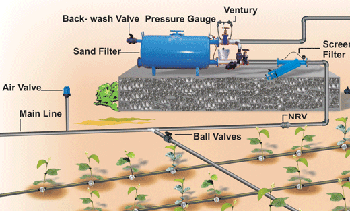
Disadvantages of drip irrigation
 Most high tech farmers will tell you that
drip irrigation is the best possible method to water your garden.
In some ways they are right --- drip irrigation minimizes your water
usage by putting the water just where your plants need it. You
don't lose water to evaporation and you don't waste water by irrigating
your aisles along with your garden beds. I have seen professional
organic farmers use drip irrigation very effectively, stringing long
pipes under black plastic in raised rows.
Most high tech farmers will tell you that
drip irrigation is the best possible method to water your garden.
In some ways they are right --- drip irrigation minimizes your water
usage by putting the water just where your plants need it. You
don't lose water to evaporation and you don't waste water by irrigating
your aisles along with your garden beds. I have seen professional
organic farmers use drip irrigation very effectively, stringing long
pipes under black plastic in raised rows.
However, for our purposes, drip irrigation failed us. Here's why:
- Drip irrigation depends on
extremely clean water. The tiniest particle of mud sucked
up by our creek pump quickly clogged the holes in our irrigation
system, which meant that the soil around the clogged holes got no
water. If you plan to install drip irrigation with anything
except city water, you will need to install a serious filter and change
it regularly.
- Drip irrigation requires a lot of hoses and they have to be moved every year if you practice crop rotation. Drip hoses with holes two feet apart for watering tomatoes will do that bed no good once you replace the tomatoes with onions spaced three inches apart.
- Drip irrigation is made for row crops, not for beds. I like to maximize space in my permanent raised beds by planting some crops --- carrots, lettuce, greens, etc. --- scattered across the entire surface. Drip irrigation just doesn't work for this setup.
- Drip irrigation is expensive. I'm a skinflint. Enough said.
- To maximize the longevity of those expensive drip hoses, you need to put them under a mulch to prevent UV damage to the plastic. Since most farmers don't have enough organic mulch to cover their entire garden, they usually end up covering the rows with that awful black plastic. Evil, evil, evil!
All of that said, we do
use drip irrigation for our perennial bush fruit. There, we made
the drip hoses ourselves out of 1 inch pipe that a friend was throwing
out, drilling holes much larger than those found in storebought drip
hoses. In permanent plantings, drip irrigation does work wonders.
| This post is part of our Irrigation lunchtime series.
Read all of the entries: |
Want more in-depth information? Browse through our books.
Or explore more posts by date or by subject.
About us: Anna Hess and Mark Hamilton spent over a decade living self-sufficiently in the mountains of Virginia before moving north to start over from scratch in the foothills of Ohio. They've experimented with permaculture, no-till gardening, trailersteading, home-based microbusinesses and much more, writing about their adventures in both blogs and books.
Want to be notified when new comments are posted on this page? Click on the RSS button after you add a comment to subscribe to the comment feed, or simply check the box beside "email replies to me" while writing your comment.
- Remove comment
